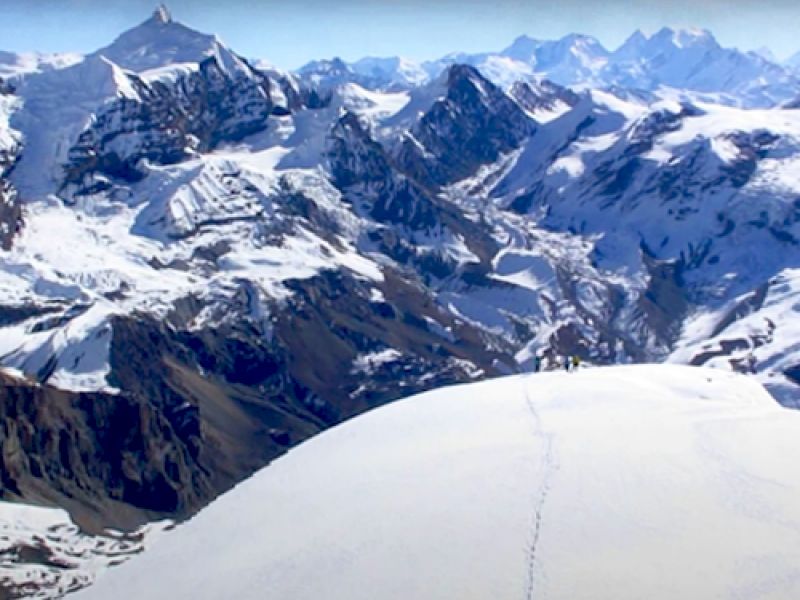Thorong Peak Climbing Overview
If you are seeking the perfect ascent and adore enjoying flora and fauna and the panoramic view of the Annapurna Himalayan ranges. In that case, Thorong Peak(6,144 m) is the best destination for you. Thorong Peak takes you to stunning mountain landscapes, charming Gurung settlements, and mind-blowing rhododendron forests. It is rising to the south of the Thorong La Pass (5,416 m/17,769 ft.) in the Annapurna Region.
Thorong Peak climbing combines classic Annapurna Circuit Trek passing the world’s highest pass, Thorong La. The top of this peak offers you a mesmerizing view of panoramic mountains like Nilgiri Peak, Tilicho Peak, Dhaulagiri Range, Annapurna Range, and an eye-catching view of the Mustang region.
On the way to Thorong Peak climbing
After the adventurous and scenic drive to Besisahar, your trek starts from the Besisahar and moves towards the Bahun Danda. Along the trail, you will be enjoying beautiful terraced fields and lush forests and reach Chame. Then your trek further continues to Manang District, where you will be completely lost in nature.
You will be amazed to see the Tibetan-influenced village and their daily lifestyle from near. The trail again moves into the Chame and then Pisang through the woods. Beautiful peaks, trees sway with blowing wind, and the aroma of nature in the air during the trip will be the best part of your life.
As you walk further, you will reach Thorong Phedi and the Thorong La, and from there, you will reach Thorong Peak. We will leave the place shortly with a heavy heart, but the returning trails will offer us beautiful attractions. On the way, you will get an opportunity to witness the holy Muktinath Temple, which is sacred to both Buddhist and Hindu temple.
The trek back to Kathmandu crosses the Kali Gandaki River passing through Jomsom, Marpha, Tatopani, and Pokhara.
How difficult is Thorong Peak climbing?
Thorong Peak is a more accessible climbing peak in Nepal. You do not need previous climbing experience, but good physical conditions and stamina are a must. You should be able to walk up and down for 5 to 7 hours a day so that your trip will be more leisurely.
Thorong Phedi is also the foot of Thorong La Pass and is the base camp for your peak climbing. The next day, we have to leave early and climb about a 35 to 40-degree inclination slope. After some hours of a climb then we finally reach the summit.
Thorong Peak climbing Accommodation
Unless you desire tents, lodging at the Thorong Peak Climbing might be in fine inns run through nearby locals. Each hotel functions as a primary public area with a fireplace, while the bedrooms are unheated and feature beds and mattresses, in addition to a blanket and pillows.
You must bring your very own sleeping bag. The showers are generally powered through gas, and a few use the iconic `drop' toilets, however, maximum now have flush systems.
The meals served for the duration of the Thorong Peak Climb are great with a mix of local Nepali / Sherpa and western dishes. There also are several cafes promoting numerous drinks, snacks, sweets, and chocolate. The maximum hard task might be avoiding all junk meals and sticking to an easy diet.
We will be camping on the Thorong Peak base camp. We are sleeping in mountain tents, which commonly sleep humans consistent with tents.
Emergency Evacuation in Thorong Peak Climbing
In Nepal, helicopter evacuations are the maximum usual method of managing an emergency, and there may be a well-set-up infrastructure for managing logistics. Incidents are uncommon, and Thororng Peak is positioned in a well-supported area in Annapurna Region.
This may take time and distance in a Himalayan surrounding like Thorong Peak. The maximum reason for delaying helicopter resources is awful weather. As a result, it's far crucial to understand that self-sufficiency and self-control are required withinside the mountains.
A helicopter evacuation may be organized through your insurance company. However, you may want to open a case and describe the situation to the insurance company.
The best advice withinside the case of altitude sickness is to keep away from risk and descend. Further elevation can quickly result in far more serious cerebral or pulmonary oedema, consequently, it is usually nice to descend if you're feeling truly unwell.
Why Himalayan Odyssey for Thorong Peak Climbing?
The Himalayan Odyssey provides the best Thorong Peak climbing package to make your once-in-a-lifetime journey safer and more memorable. We are an experienced travel provider. Our team is highly-versed in mountain emergency medical care, as well as ascent and trekking.
We put a priority on the quality and well-being of our guests. We guarantee an extra pleasurable adventure with our joyful and helpful staff. Our cuisine, housing, and other services are the first. If you have already have done Thorong peak climbing we have some similar outstanding peak climbing here you can check Island peak climbing and Mera peak climbing.
We want you to succeed, and we're here to help you reach the top of Thorong Peak. It's time to book your Thorong Peak Climbing adventure.





